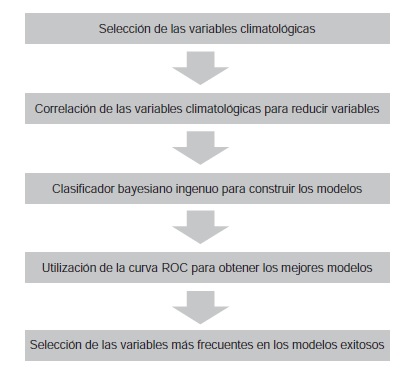Prediction of the respiratory syncitial virus epidemic using climate variables in Bogotá, D.C.
Abstract
lntroduction: The respiratory syncitial virus is one of the most common causes of mortality in children and older adults in the world. Objective: To predict the initial week of outbreaks and to establish the most relevant climate variables using naive Bayes classifiers and receiver operating characteristic curves (ROC). Materials and methods: The initial dates of the outbreaks in children less than five years old for the period 2005-2010 were obtained for Bogotá, Colombia. We selected the climatological variables using a correlation matrix and we constructed 1,020 models using different climatological variables and data from different weeks previous to the initial outbreak. In addition, we selected models using a six-year period (2005-2010), a four-year period (2005-2008), and a two-year period (2009-2010). We obtained the best predictive models and the most relevant climatological variables to predict the outbreak using naive Bayes classifiers and ROC curves. Results: The best models were those using a two-year period (2009-2010) and week 0, with 52% and 60% of effectiveness, respectively. Humidity was the most frequent variable in the best models (62%). Conclusions: We used naive Bayes classifiers to establish the best models to predict correctly the initial week of the outbreak. Our results suggest that the best models used humidity, wind speed and minimum temperature in outbreaks prediction.
Downloads
References
Benguigui Y, López FJ, Sdhmunis G, Yunes J. Infecciones respiratorias en niños. Serie HCT/AIEPI-1. Washington, D.C.: Organización Panamericana de la Salud; 1997. p. 496.
López-Cuadrado T, de Mateo S, Jiménez-Jorge S, Savulescu C, Larrauri A. Influenza-related mortality in Spain, 1999-2005. Gac Sanit. 2012;26:325-9. http://dx.doi.org/10.1016/j.gaceta.2011.09.033
van Woensel JB, van Aaldersen WM, Kimpen JL. Viral lower respiratory tract infection in infants and young children. BMJ. 2003;327:36-40. http://dx.doi.org/10.1136/bmj.327.7405.36
Aranda-Lozano DF, González-Parra GC, Querales J. Modelamiento de la transmisión del virus respiratorio sincitial (VRS) en niños menores de cinco años. Rev Salud Pública. 2013;15:637-47.
Rodríguez J, Prieto S, Correa C, Arnold Y, Álvarez L, Bernal P, et al. Dynamics of the dengue epidemic in Colombia: Predictions of the epidemic trajectory. Rev Fac Med. 2013;21:38-45.
Núñez LM, Aranda DF, Jaramillo AC, Moyano LF, Osorio ED. Chronology of a pandemic: The new influenza A (H1N1) in Bogotá, 2009-2010. Rev Salud Pública. 2011;13:480-91. http://dx.doi.org/10.1590/S0124-00642011000300010
González-Parra GC, Villanueva-Micó RJ, Segovia L. Dinámica del virus pandémico AH1N1/09 en la población de Venezuela. Interciencia. 2012;37;306-11.
González-Parra G, Villanueva RJ, Ruiz-Baragaño J, Moraño JA. Modelling influenza A (H1N1) 2009 epidemics using a random network in a distributed computing environ-ment. Acta Trop. 2015;143:29-35. http://dx.doi.org/10.1016/j.actatropica.2014.12.008
Adarme LV, Castellanos JE. Diagnóstico virológico de la infección por virus sincitial respiratorio. Revista Salud Bosque. 2015;3:23-36.
Walton NA, Poynton MR, Gesteland PH, Maloney C, Staes C, Facelli JC. Predicting the start week of respiratory syncytial virus outbreaks using real time weather variables. BMC Med Inform Decis Mak. 2010;10:68. http://dx.doi.org/10.1186/1472-6947-10-68
Russell S, Norvig P. Intelligence A. A modern approach. Artificial Intelligence. Prentice-Hall, Englewood Cliffs. 1995; 25:27.
Domingos P, Pazzani M. On the optimality of the simple Bayesian classifier under zero-one loss. Mach Learn. 1997; 29:103-30. http://dx.doi.org/10.1023/A:1007413511361
Noguera T. Metodología ROC en la evaluación de medidas antropométricas como marcadores de la hipertensión arterial. Aplicación a población gallega adulta (tesis). Santiago de Compostela: Universidad Santiago de Compostela; 2010.
Lim TS, Loh WY, Shih YS. An empirical comparison of decision trees and other classification methods. Technical report 979. Madison, WI: University of Wisconsin; 1997.
Noyola DE, Mandeville PB. Effect of climatological factors on respiratory syncytial virus epidemics. Epidemiol Infect. 2008;136:1328-32. http://dx.doi.org/10.1017/S0950268807 000143
Omer SB, Sutanto A, Sarwo H, Linehan M, Djelantik IG, Mercer D, et al. Climatic, temporal, and geographic characteristics of respiratory syncytial virus disease in a tropical island population. Epidemiol Infect. 2008;136:1319-27. http://dx.doi.org/10.1017/S0950268807000015
Yusuf S, Piedimonte G, Auais A, Demmler G, Krishnan S, van Caeseele P, et al. The relationship of meteorological conditions to the epidemic activity of respiratory syncytial virus. Epidemiol Infect. 2007;135:1077-90. http://dx.doi.org/10.1017/S095026880600776X
Fawcett T. An introduction to ROC analysis. Pattern Recognit Lett. 2006;27:861-74. http://dx.doi.org/10.1016/j.patrec.2005.10.010
Ting SL, Ip WH, Tsang AH. Is naive Bayes a good classi-fier for document classification? International Journal of Software Engineering and its Applications. 2011;5:37-46.
Welliver R. The relationship of meteorological conditions to the epidemic activity of respiratory syncytial virus. Paediatr Respir Rev. 2009;10(Suppl.1):6-8. http://dx.doi.org/10.1016/S1526-0542(09)70004-1
Tang JW, Loh TP. Correlations between climate factors and incidence –a contributor to RSV seasonality. Rev Med Virol. 2014;24:15-34. http://dx.doi.org/10.1002/rmv.1771
Welliver RC. Temperature, humidity, and ultraviolet B radiation predict community respiratory syncytial virus activity. Pediatr Infect Dis J. 2007;26(Suppl.11):S29-35. http://dx.doi.org/10.1097/INF.0b013e318157da59
Meerhoff TJ, Paget JW, Kimpen JL, Schellevis F. Variation of respiratory syncytial virus and the relation with meteorological factors in different winter seasons. Pediatr Infect Dis J. 2009;28:860-6. http://dx.doi.org/10.1097/INF. 0b013e3181a3e949
Stewart PD. Seasonality and selective trends in viral acute respiratory tract infections. Med Hypotheses. 2016;86:104-19. http://dx.doi.org/10.1016/j.mehy.2015.11.005
Rodríguez-Martínez CE, Sossa-Briceño MP, Acuña-Cordero R. Relationship between meteorological condi-tions and respiratory syncytial virus in a tropical country. Epidemiol Infect. 2015;143:2679-86. http://dx.doi.org/10. 1017/S0950268814003793
Onozuka D. The influence of diurnal temperature range on the incidence of respiratory syncytial virus in Japan. Epidemiol Infect. 2015;143:813-20. http://dx.doi.org/10.1017/S0950268814001575

| Article metrics | |
|---|---|
| Abstract views | |
| Galley vies | |
| PDF Views | |
| HTML views | |
| Other views | |

























